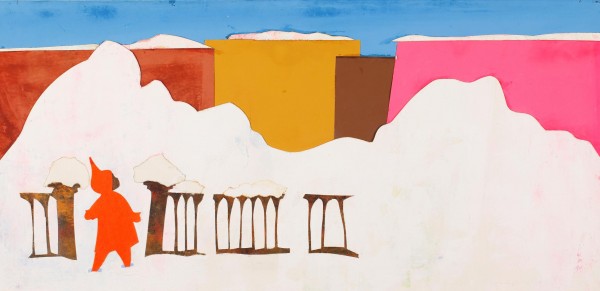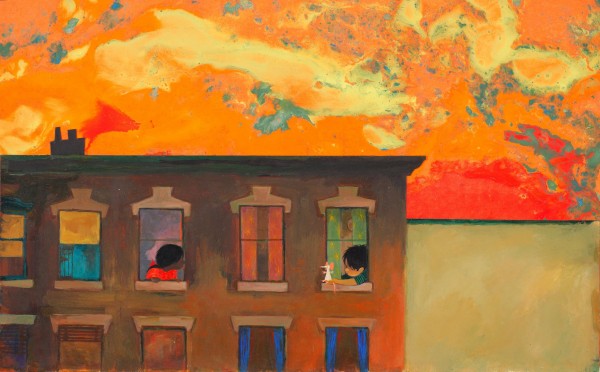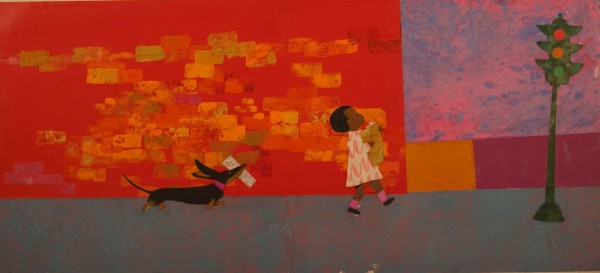
“The Snowy Day and the Art of Ezra Jack Keats” at Akron Art Museum
Art museums seem to take on a whole different character when the show being exhibited has its focus in one way or another on children. That’s the case with the current display at the Akron Art Museum, a Knight Arts grantee.
“The Snowy Day and the Art of Ezra Jack Keats” – an exhibition that pays tribute to award-winning author and illustrator Ezra Jack Keats (born Jacob Ezra Katz in Brooklyn, NY) – is one that children will enjoy. Certainly they will like the illustrations from his famous books, like “Whistle for Willie,” “Peter’s Chair,” or his signature work “The Snowy Day.”
Ezra Jack Keats, “After breakfast he put on his snowsuit and ran outside,” from “The Snowy Day.” Photo courtesy of the Akron Art Museum
Something special lurks in one of the galleries though. There’s a large reading room installation designed from the “neighborhood” that Keats depicted in his images. On Fridays at 11:15 a.m. museum educators and staff will read picture book classics and contemporary tales. The concept helps to bring to life the illustrative material that densely covers the walls of the various rooms.
Ezra Jack Keats, “It was hot. After supper Roberto came to his window to talk with Amy,” from “Dreams.” Photo courtesy of Akron Art Museum
At the opening reception, stage performers from Actors’ Summit, a Knight Arts grantee, held many children in thrall with their readings.
For adult viewers there is the opportunity to ponder the significant amount of material and learn much about the artist, his life and worldview, the way he worked, and the like, but glimpse a slice of social history in the process.
“The Snowy Day” display is organized in six sections – from the Introduction, which gathers together images and panels that are presumably self-portraits of the artist, to the Conclusion, which brings back around images of his boyhood neighborhood that Keats immortalized in his art.
Ezra Jack Keats, “Peter’s mother asked him and Willie to go on an errand to the grocery store,” from “Whistle for Willie.” Photo courtesy of Akron Art Museum
In between are thematically organized sections: “Coming of Age in Brooklyn,” where we see clearly his images of tenement life – broken doors, trash cans, graffiti-laden walls and fences, and the like, which was a first as a topic in children’s literature; “Bringing the Background to the Foreground” (wherein Keats’ 1934 award-winning “Shantytown” image is displayed to show the author’s attempt to reveal persistent social problems); “The Snowy Day” (with special emphasis on critical reception of this significant book and its illustrations); “Peter’s Neighborhood” (which features the artist’s key and distinctive image elements of abandoned spaces, ruined umbrellas, overflowing city garbage cans, etc.); “Keats in the Studio” (where viewers can see his palette, brushes, and the pieces of fabric and other materials that he collected to use with his collages); and “Spirituality, Nature, and Asian Art” (which shows the artist’s fascination with haiku poems).
“The Snowy Day and the Art of Ezra Jack Keats” will be on display Wednesday-Sunday, 11 a.m.-5 p.m., with extended hours until 9 p.m. on Thursday, through June 30 at the Akron Art Museum, 1 S. High St., Akron; 330-376-9185; www.akronartmuseum.org. Admission for all exhibits is $7 ($5 for students and seniors).
Recent Content
-
Artsarticle ·
-
Artsarticle ·
-
Artsarticle ·



